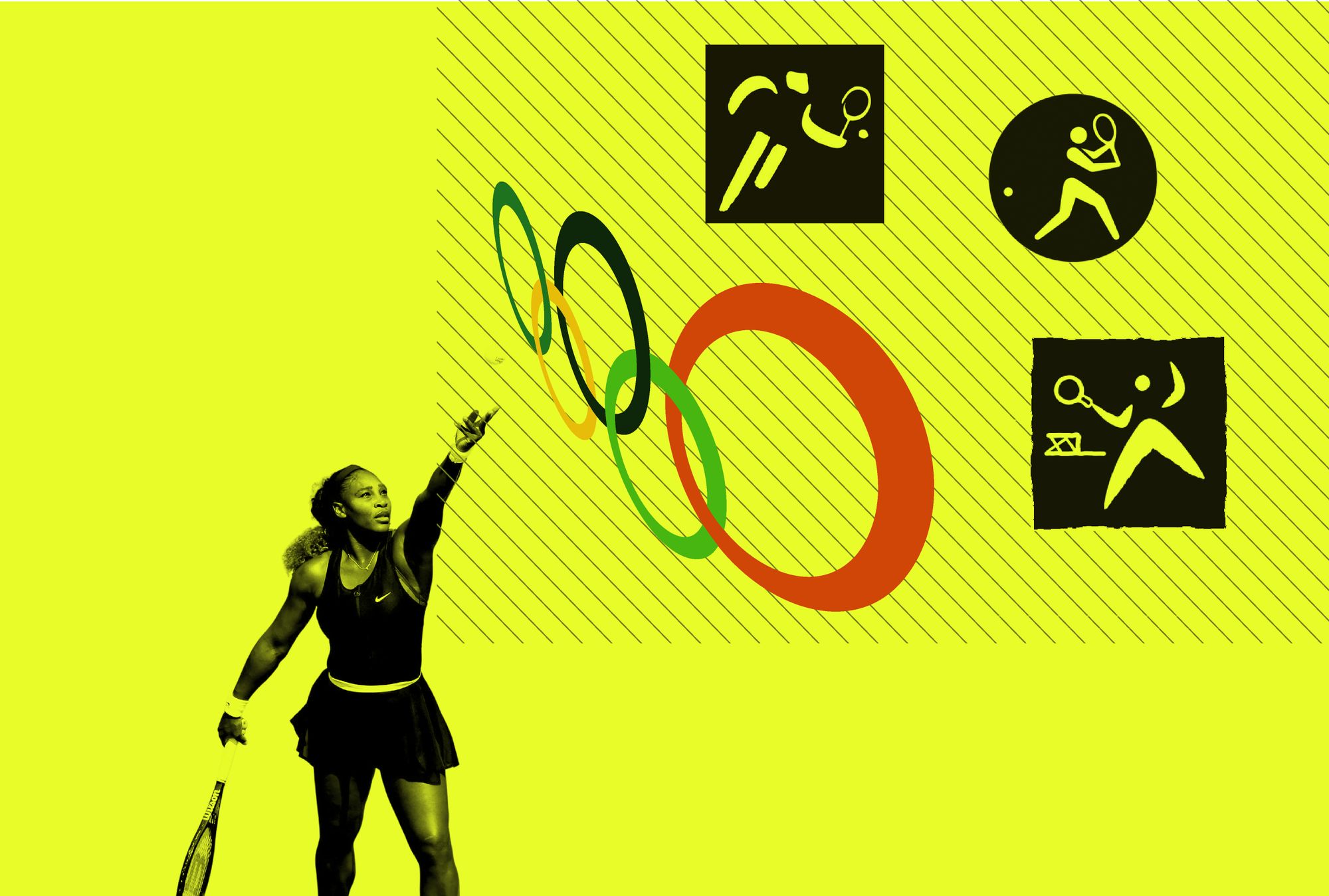
A circle atop four connected vertical lines: the ubiquitous stick figure transcends cultures to be how we humans all now recognize and represent ourselves. Every day, we rely on a significant number of pictograms to navigate the physical, social, and digital realms of our everyday lives. Pictograms guide us everywhere—on street crossings, bathroom doors, sport facilities, and even on our mobile phones. Said to be neutral and universal, they supposedly communicate effortlessly when words fall short. But can we confidently claim the pedestrian sign is neutral, when a survey showed that 98% of respondents perceive it as male? What does this signify about our culture? An even better question, perhaps, is how did this sign—or any other “universal” sign—come into being in the first place?
Faster, Higher, Stronger
Despite their ubiquity today, most of us are unaware that the pedestrian sign has deep ties to the history of sports—more precisely, the history of the modern Olympic Games. Originating in Ancient Greece 3,000 years ago, the Olympic Games were revived in the late 19th century. Since then, it has become the world’s most renowned and revered sporting competition. In 1894, the French aristocrat Pierre de Coubertin founded the International Olympic Committee (IOC), believing that the Games could create a platform to overcome nationalism and strengthen world peace. Universality and political neutrality still remain the main pillars of the IOC Code of Ethics, which strictly prohibits athletes from political expression. Nevertheless, the Olympics has always been a site of geopolitical tensions and public displays of power, and athletes have always used the playing field to make political statements, despite severe penalties including being banned from future competitions.
Despite its false claim of “neutrality,” since its first edition in Athens 1896, the modern Olympic Games have also been openly sexist. Coubertin held strong convictions about not including women in the Games, since he believed that only superior male athletes—epitomized by the Olympic motto Citius Altius Fortius (Faster Higher Stronger)—were qualified to compete. In the Olympic Review of 1912, Coubertin described the Games as “the solemn and periodic exaltation of male athleticism, with internationalism as a base, loyalty as a means, art for its setting, and female applause as reward.”
After an all-male first edition, the 1900 Games in Paris allowed women to compete in five sports: tennis, sailing, croquet, equestrianism, and golf. Since then, year after year, new disciplines have opened their doors to women. This trend continued up to quite recently in the 2012 London Games, with the final addition of boxing. Even with this inclusion, the male contingent still outweighs the female contingent of competitors, with the pinnacle of female participation still only at 45% during the most recent Olympics in 2016 in Rio de Janeiro, Brazil.
“A study from 2019 exploring portrayals of Olympic athletes over the last 60 years suggests that female athletes are still more likely to be depicted in sexually objectifying ways.”
In his book Olympic Games Design, graphic designer and design historian Markus Osterwalder shows an unofficial poster of the first Olympics in 1896. It portrays a young woman embodying the goddess Athena, holding an olive wreath and a laurel branch while looking over the stadium—a space where she was only allowed to enter as a spectator. In this first rendition of the Olympics, women were portrayed on posters in accessory roles such as protecting the Olympic flame or handing out medals. Soon afterwards, this representation turned into objectification, exemplified in the poster of the 1900 Games in Paris, which depicts a female fencer dressed in tight, black attire, her body proportions distorted and devised in a way to please the male gaze. In the following years, we mostly see women in advertising posters in similar roles rather than in the official Olympic posters, where the universal male body remained the center of attention. The same patterns continue until today: a study from 2019 exploring portrayals of Olympic athletes over the last 60 years suggests that female athletes are still more likely to be depicted in sexually objectifying ways.
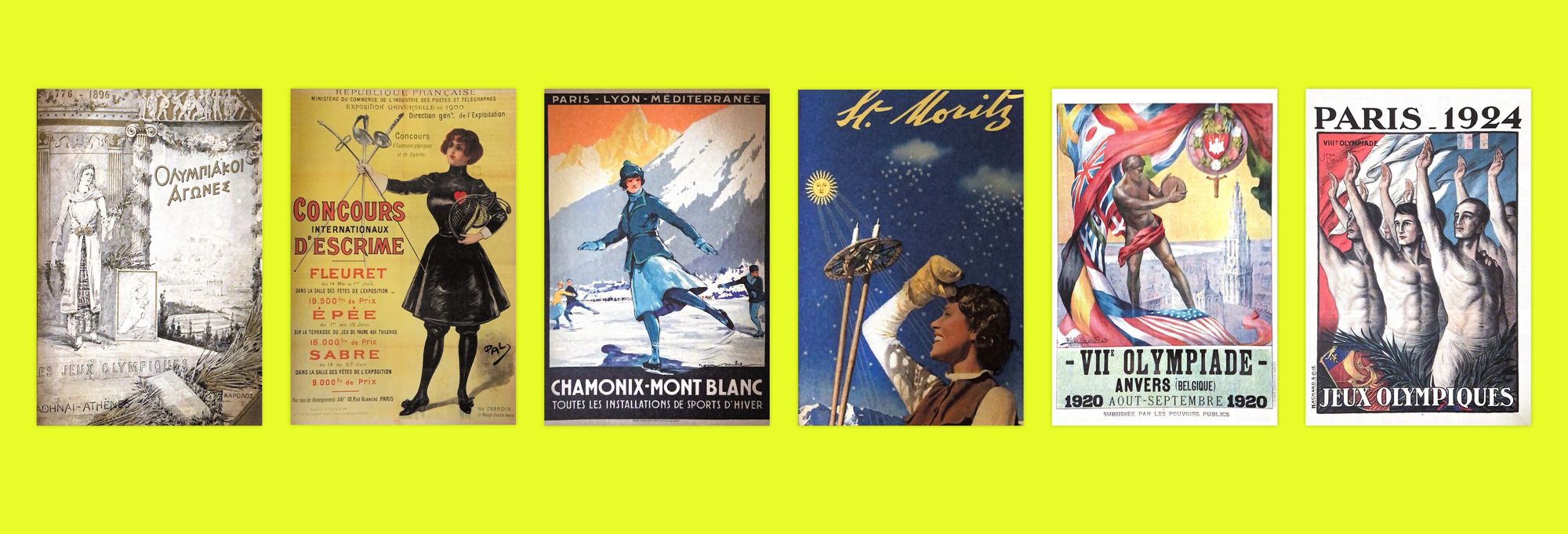
In the early 1920s, Viennese philosopher Otto Neurath teamed up with designers Marie Reidemeister and Gernd Arntz to create the System of Typographic Picture Education, known as ISOTYPE. Pictograms were integral to ISOTYPE, helping to quantify and compare data, as well as provide a language-like consistency to assist in the organization’s broader educational objectives. Although the creators of ISOTYPE claimed that all of their symbols carried the same value, researcher and designer Asja Keeman pointed out that those pictograms manifested the colonial standards of the time, with the various races and ethnicities being portrayed through orientalist tropes and stereotypical references. Furthermore, the system centered white men, with all others being represented as deviations of that norm—a practice that still lingers today in the emojis on our phones.
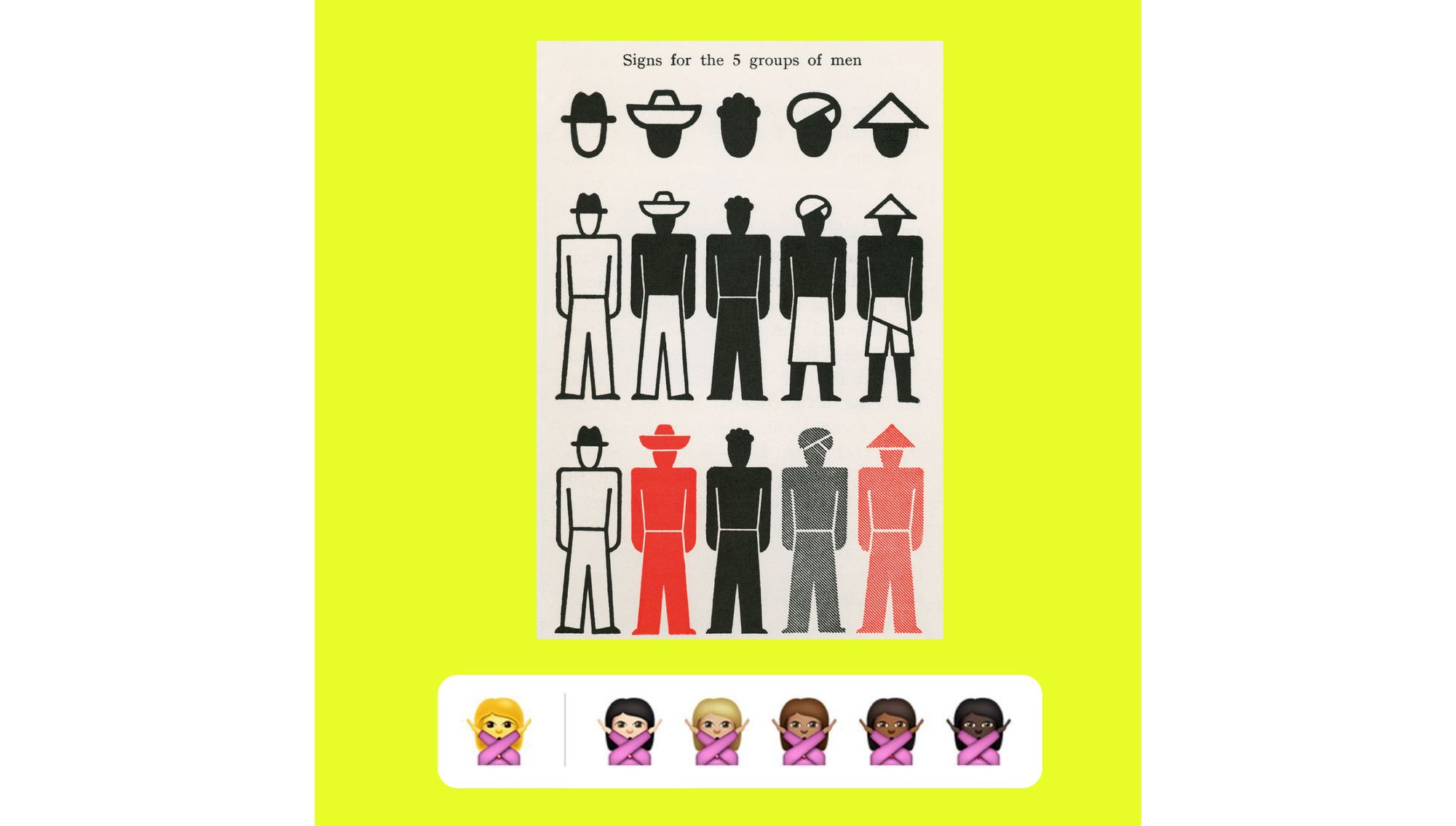
The Stockholm 1912 Games and Paris 1924 Games utilized complex illustrative icons, which today are classified as sports illustrations, although they already fulfilled the main function of the modern pictogram: to be interpreted internationally without the use of verbal language. In the following decades, the elimination of details and simplified human figures championed by ISOTYPE became the standard for pictogram design, and were subsequently incorporated by the visual identity of the Olympics.
Despite the IOC’s efforts to hide its dark history, the first modern Olympic pictograms appeared during the Berlin 1936 Games hosted by Nazi Germany. Athletic nationalism was brought to a peak by Hitler, who used the Olympics to propagandize the Third Reich and white supremacy, and to justify eugenics. The swastika, the symbol of National Socialism in Germany, was prevalent during the Games. Throughout all German athletic institutions, Nazi Germany adhered to an “Aryans-only” policy, and many Jewish athletes were later murdered in the Holocaust. Moreover, the torch relay, and the broadcasting of the Olympics began that year, which established a very strong sense of nationalism.
Although sports illustrations were reintroduced in the London 1948 and Helsinki 1952 Games, the first systematic use of pictograms was at the 1964 Olympics. Designed by Yusaku Kamekura and a team of 11 designers for the Games in Tokyo, the set introduced a new reduced and simplified language, which became a standard for the following games, and later contributed to the striving field of corporate design. Over the next three decades, pictograms followed the same logic with minor style differences, always representing athletes in typical unambiguous poses with sports equipment. It is notable that, from Tokyo 1964 onwards, all editions also made their own signage pictograms including toilet signs, and in some cases even cultural pictograms. Suddenly, pictogram sets were no longer limited to sports, but they started invading everyday life.
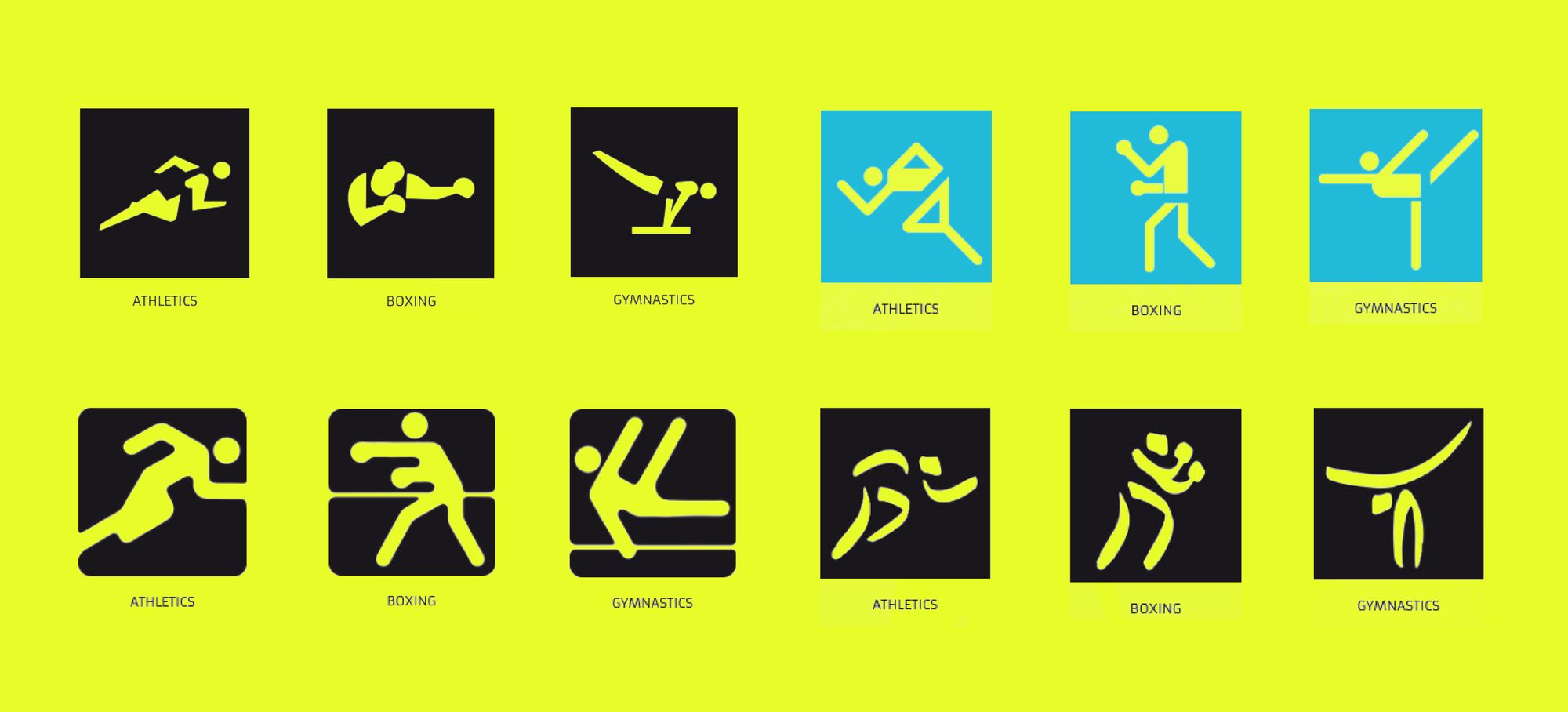
Indeed, until 1964, there was no unified set of signage systems or wayfinding pictograms elsewhere. In her research “Put a skirt on it,” graphic designer Maggie Wolicki explains how the Tokyo pictograms, followed by the 1972 Munich pictograms, motivated a collaboration between the American Institute of Graphic Arts (AIGA) and the Department of Transportation (DOT) to create a unified set of pictograms for different travel situations in the U.S.A. This set, developed between 1974–1979, led to the ubiquitous signs which today blend into the design of everyday things. This shows how design can be integrated into hegemony—creation and observance eventually morphs into acceptance.
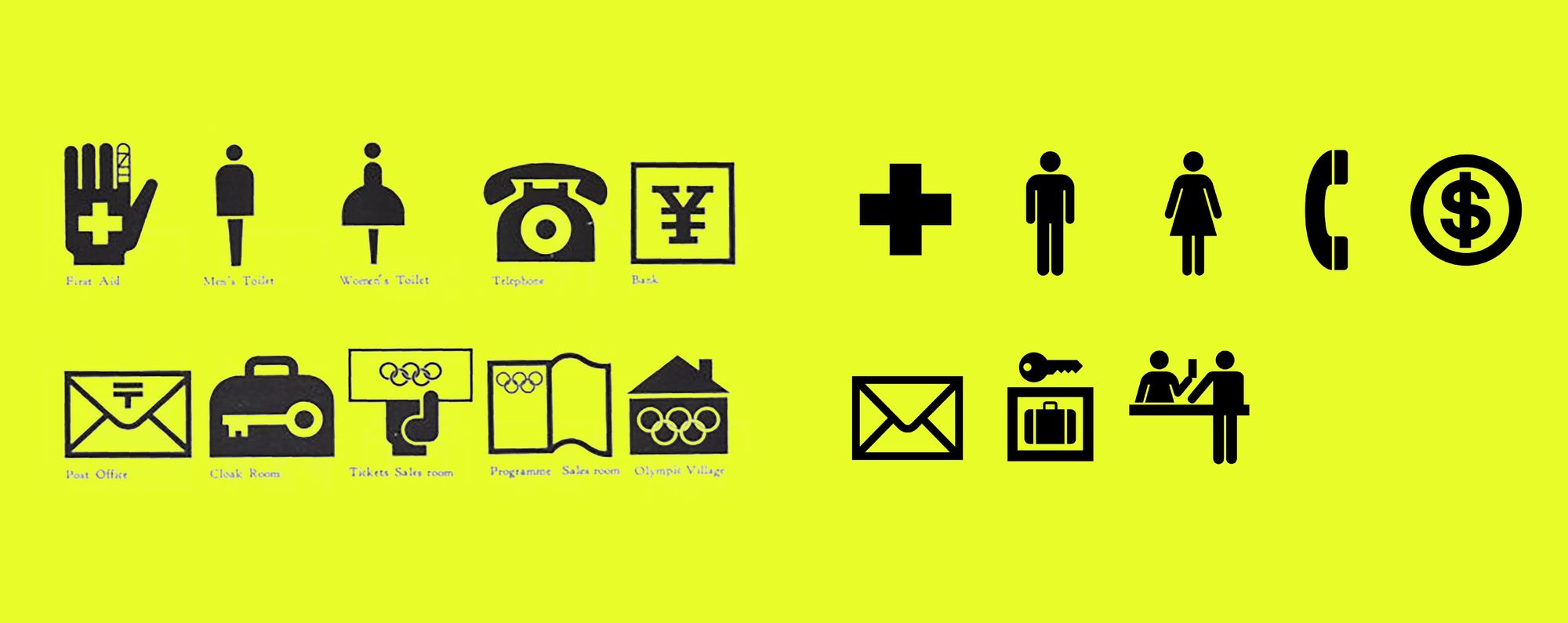
The binary lens of design
This is how most “wayfinding” that we heavily depend on today bears the legacy of the Olympics, and by consequence the representation of a universal athletic body which is that of “a superior male.” Graphic designers and researchers Tania Quindós and Elena González-Miranda have demonstrated that the female sign is in fact a modified version of the male pictogram, to which a dress was superficially added. In other words: man is the norm, and woman the deviation of that norm.
“Day after day, pictogram after pictogram, we are trained to see the world in binaries.”
But this normative system is far more reaching. It also divides bodies within a strict gender-binary. Queer theorist Judith Butler introduced the idea that “gender” and “heterosexuality” are not natural traits, but instead are perceived and performed by endless repetition. Day after day, pictogram after pictogram, we are trained to see the world in binaries. Butler also proposes to understand the body as simultaneously produced by and constitutive of social meanings. In that sense, pictograms do not only reflect the cisgendered heteropatriarchal society in which they were created, but they also help perpetuate those very systems of oppression.
In a 1990 study, sport sociologists Susan Birrell and Cheryl L.Cole examined the role of sports as not only a gender producing and affirming system; but also as a system that constructs “difference” and unevenly distributes dominance and power. One example of this can be seen in the case of Renée Richards, a U.S. tennis player who had gender affirmation surgeries and returned to the sport to compete as a woman in 1976. This demonstrates how sports establishes and articulates the fallacy that there are two and only two universal, bipolar, mutually exclusive “sexes,” and that each of them corresponds to traditional discourse of femininity and masculinity with gendered behaviours. Sports sociologist Mary Jo Kane has further examined the implications of this “difference and power producing system” by looking into gender segregationist policies, which are entangled with every facet of the Olympics: from the clear-cut division between men’s and women’s sports, to the decisions on which bodies are construed as “true” female athletes eligible to compete, and how bodies that do not conform to Western heteronormative expectations of femininity are subsequently punished.
One common argument claims that segregation is beneficial to women, as they need to be “protected” from getting hurt. I myself vividly remember my physical education classes; as teenagers, we were strictly divided into two groups: girls and boys. During the full tenure of my school years, I experienced how those socially constructed divisions were rigidly maintained and remained firmly entrenched. Unsurprisingly, as girls, we were trained to believe that we possessed innately inferior physical capacities compared to boys, so accepting this segregation as “natural” was also a part of the deal—and supposedly “beneficial” to us.
“Segregationist policies contribute to the gender binary, as the athletic bodies they produce are the ones we are allowed to see within this hegemonic and patriarchal framework.”
However, Mary Jo Kane argues that it is actually men’s—not women’s—interests that are being protected when segregationist policies keep us from seeing women outperform men, as this threatens the very idea of men’s superiority in athletic prowess. Segregationist policies contribute to the gender binary, as the athletic bodies they produce are the ones we are allowed to see within this hegemonic and patriarchal framework. Mary Jo Kane stresses how we are more likely to see female gymnasts or figure skaters portrayed in the media as they own a recognizable “feminine” body, which is of a certain size and general configuration. Having felt such immense pressure to be thin myself, I experienced stigmatization in sports from the early years of my childhood as a result of not fitting into those waif-like body standards of gymnastics.
“Inclusive” oppression in design
If pictograms have been enmeshed in systems of oppression, have there been attempts to fight these very systems, and promote more counter-hegemonic representations of sports? The first pictogram set that caught my attention was that of Mexico 1968. It differed from the other sets as it did not center a “universal body” but represented sections of the body or the sports equipment associated with each sport, thus appearing more inclusive—or at least it did, until I further investigated its history.

Initially, students from the Universidad Iberoamericana in Mexico City worked on this set, but in January 1967, New York-based graphic designer Lance Wyman won an international competition and took over its development. This is why, in most of the sources, Wyman is credited as the sole author of the visual identity for the 1968 Games, despite it being a collective effort. This distinction is crucial when we consider the political background of the Games at the time: 1968 witnessed the protests of thousands who stood against the government’s apathy to the country’s social issues, and scores of Mexican students were shot dead just 10 days before the start of the Games.
In an interview with me over Zoom, Wyman indicated that he wasn’t considering representing “men and women,” but just looking for how to best represent a particular sport. It goes without saying that this belief does not mean that his designs are free from bias. The appropriative nature of his designs is even more disturbing. At the time when he was given the task, Wyman did not know anything about Mexico, so he went to the Museum of Anthropology in Mexico City to study artifacts from the pre-Colombian era, such as the Aztec Sun Stone and ancient Mayan murals. In a podcast episode by 99% Invisible, Wyman recalls being amazed by the “advancement” of the indigenous cultures in Mexico. Those artifacts reminded him of Op Art, which at the time was quite popular in New York. The hypnotic Mexico 68 logo was therefore designed by appropriating indigenous artifacts and twisting them with Op Art aesthetics. During our conversation, Wyman also credited the Berlin 1936 pictograms—which are entangled with Nazi ideology—as the “best designed” pictograms, even while acknowledging the terrible history they left behind. Perhaps his admiration of their concept explains the strong visual similarity between Berlin 1936 and Mexico 1968—putting focus on sports equipment rather than on sports figures. After the Games, Wyman remained in the country and even designed pictograms for the subway system of Mexico City using the same approach which is in use until today—an example of how this colonizing approach has left a permanent mark.
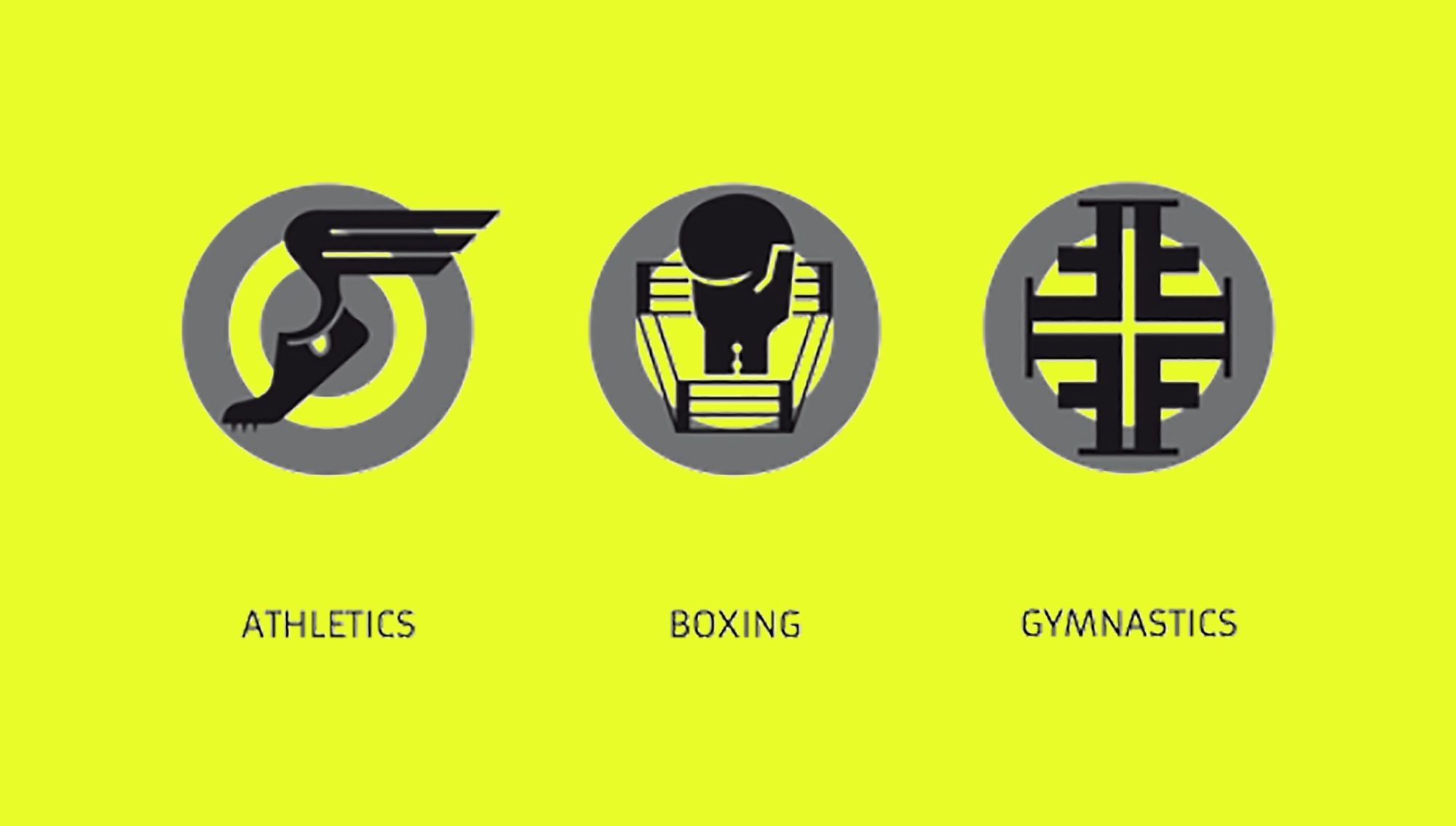
Lance Wyman’s pictograms are not the only example of the colonizing design practice in the Olympics. Sydney 2000 pictograms designed by white designers in Saunders Design Group are known today for their “striking” concept, which was based on the boomerang—a traditional hunting tool, with the goal of “paying homage” to Australian Aboriginal cultures. Meanwhile, the truth of Australia’s dark history of the mass killings of Aboriginal people was hiding in plain sight. Indeed, architect and professor Jilly Traganau points out how the Olympics have been accused of perpetuating (and in some cases even promoting) colonial policies and practices by host nations and cities, either through associated parties or directly by Olympic bodies such as the International Olympic Committee, the host organizing committee and official sponsors.
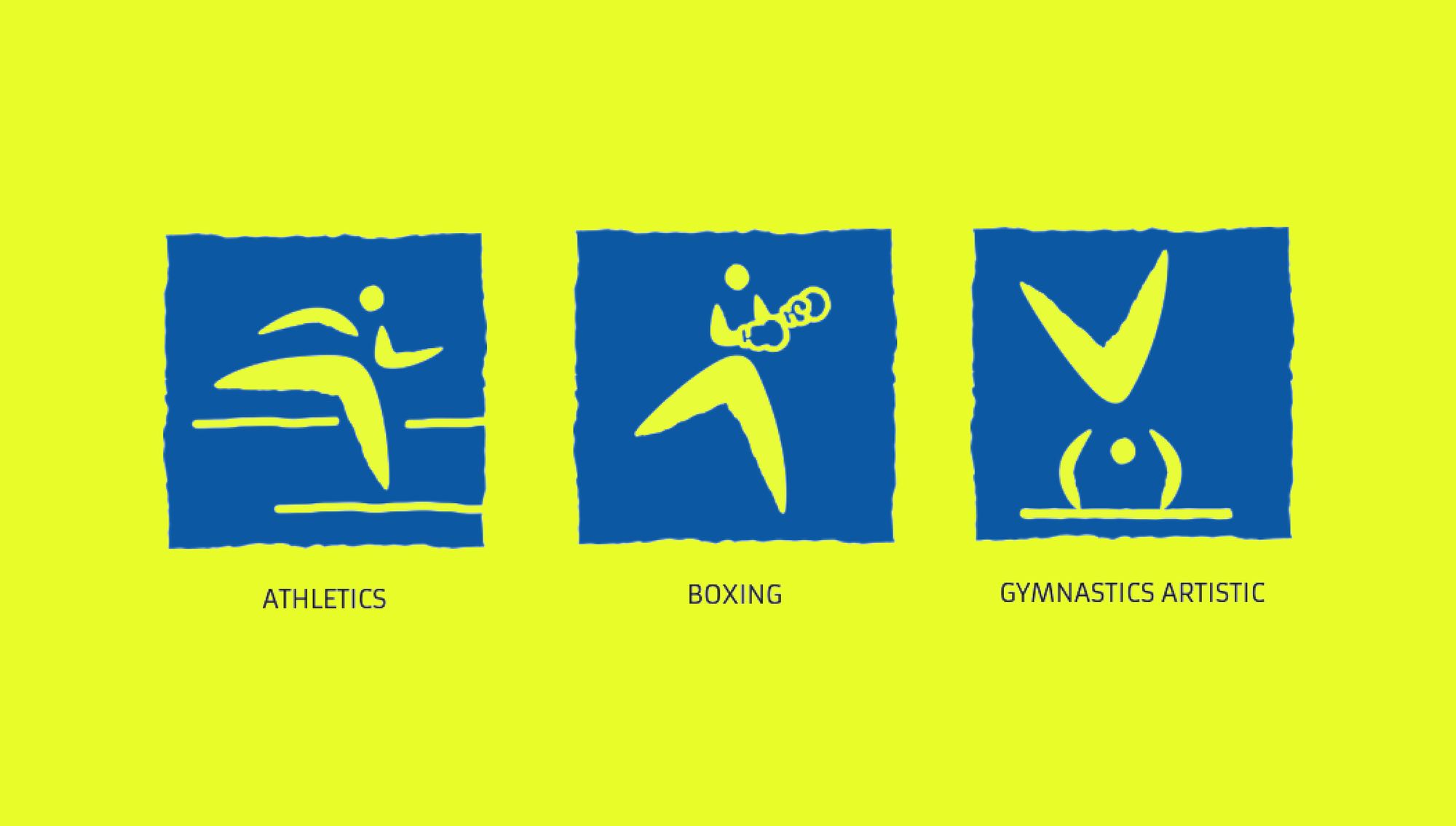
Resisting cis-normativity
Mexico 1968 also marked the beginning of “mandatory gender verification testing,” the IOC’s repressive policy that challenged the appearance of “masculine” women and forced them to “prove” their femaleness. Stemming from the controversy over the prowess of the German “Wonder Girls” and allegations of doping, the earliest forms of these tests included a nude parade in front of a panel of doctors. Though later, more technological iterations were perhaps less invasive and humiliating, they were still highly controversial and objectionable until their eventual removal in 2000—when they were replaced with a new policy that allowed medical experts to request testing if an athlete’s sex was called into question.

As pointed out by sports writer Craig Lord, after the building of the Berlin Wall in 1961, East Germany used sports supremacy as a legitimization tool to gain international recognition. For the first time in Tokyo 1964, the German Democratic Republic (GDR), a country of 17 million inhabitants, won more gold medals than their West German counterparts. Afterwards, the medals kept increasing. It was eventually revealed that behind the scenes, athletes were given performance-enhancing drugs. This was organized as part of a national doping program with roots in the 1960s, which targeted mostly female athletes. Doping existed in other countries as well, but the GDR was unique as the program was state-commissioned.
The Stasi—the GDR state secret police—coordinated systematic doping of East German athletes from 1971 until the reunification of Germany in 1990, to ensure that information about the use of such heavy drugs would not leak into the public. Athletes—some as young as 10 years old—were told by their coaches that those were “just blue vitamin pills,” and their parents were not asked for consent. Steroids included the synthetic anabolic agent Oral-Turinabol, produced by the East German company Jenaphram, testosterone derivatives, and other dangerous substances which were used on the sportswomen without proper licensing. According to the 1965 paper, when used over a long period of time or at high dosages, anabolic steroids could lead to chronic acne, virilization effects, growth of facial hair, increased sexual appetite, and clitoral hypertrophy. The program affected an estimated 10,000 to 15,000 athletes, who up to today may be suffering from physical and psychological damage. In 2006, only 183 victims received compensation from the German Olympic Sports Organisation (DOSB) and the drug company.
The GDR Wonder Girls were later labelled as “deviant-mutants”—a term which, as Mary Jo Kane explains, has been used to describe female athletes who, due to their athletic competence or physical characteristics, deviate so much from traditional conceptions of femininity that they are viewed as outliers, posing a danger to men as they are capable of outperforming them and breaking the link between athletic prowess and masculinity. It is hard to track down the first usage of this label, but records show that it was used in the media coverage of Renée Richards, one of the first openly transgender Olympic athletes.
The GDR Wonder Girls were victimized and exploited to serve the interests of the state. However, this is only one way to look at their story; one that reduces their existence to being mere doping cheaters, and overshadows the fact that those women were great athletes who were training day and night. Furthermore, their performances showed the sports world that women do not have to be “feminine” in a classical and typical sense of the word in order to achieve success in sports. The fact that they were bringing home medals gave people reason to accept their masculinized bodies as they were.
So, instead of looking at how they challenged patriarchal and hegemonic structures of the sports, why is it that we tend to see them only through the lens of state propaganda of East Germany? Is it because they threatened the gender binary, and that makes people feel uncomfortable? As sport scholars Heather Reid and Michael Austin noted in their book The Olympics and Philosophy, despite having paid a high price, the GDR Wonder Girls also transformed the traditional conception of modern sport as a males-only arena. They managed to shake the patriarchal structure of sports, which still remains steeped in notions of “masculinity,” “maleness” and the domination of the gender dichotomy.
Jezebel athletes
Today, the implications of the “deviant-mutant” label remain alive in the modern spirit of Olympics. For over a decade, the very accomplished and well-known tennis player, Serena Williams, who has been breaking records in the tennis world since 1999, has been a target of the “Jezebel” media stereotype. Patricia Hill Collins, whose scholarship examines issues of race, gender, social class, sexuality and beyond, describes in her book Black Feminist Thought how the “Jezebel” label is representative of deviant Black female sexuality “whose function was to relegate all Black women to the category of sexually-aggressive women.” Such sexually aggressive women are simultaneously seen as “available,” “controlling,” and closer to masculinity than white women. During the 2018 U.S. Open Final, the Australia’s Herald Sun newspaper, published an extremely racist cartoon interpretation of Serena Williams when she lost the game to Naomi Osaka. Despite the significant level of backlash and criticism on social media, the cartoon was never removed, and the artist, Mark Knight, even received support from the newspaper.
Much of the violent media commentary latches on to female athletes who, like Serena Williams, have strong, muscular, athletic bodies, which are scrutinized by society’s perception and representation of a “typical” female athlete. An ethnographic social media study around Serena Williams shows that comments directed at her incorporated several types of abuse which could only be directed at a Black female athlete, and can therefore only be understood through the lens of intersectionality.

Another Black female athlete with a history of divisive media coverage is South African track star Caster Semenya, who won a gold medal in the women’s 800-meter competition on August 19, 2009. On the same day, the International Association of Athletics Federations (IAAF) required Semenya to undergo gender verification testing. The results, consisting of unverified claims about Semenya having an intersex trait, were meant to kept confidential, but somehow were leaked to the press and caused a scandal. It took almost one year before the IAAF and a panel of medical experts decided that Semenya could return to competition at a low-profile track-and-field event in Finland. In 2019, new IAAF rules came into force, preventing women with naturally higher testosterone levels—such as Semenya—from participating in 400m, 800m, and 1500m events unless they take medication to lower their testosterone levels.
The rationale behind the Olympics’ decision was to ensure “a level playing field,” as they believed that women with higher testosterone levels would have an unfair advantage over other women with “normal” levels of testosterone, even though there is no any scientifically proven evidence showing that successful athletes have higher levels of testosterone compared to less successful ones. In a 2013 article published in The Journal of Sex Research, sport sociologists Cheryl Cooky and Shari Dworkin also argue that if their goal is to ensure “fairness,” then athletes should also be tested for ‘‘performance enhancing genes that predispose them to be athletically superior’’ by improving muscle growth and efficiency, as well as blood flow to skeletal muscles.
“Male athletes never had to undergo such [gender verification] tests, since their superiority was always perceived as inherently ‘natural’ and thus fair.”
What also makes gender verification testing very problematic and controversial on many levels is that those tests are only targeted at women. From her early years growing up in Limpopo, Semenya realized she was different. “I have a deep voice, I don’t have boobs, I play around with boys. It does not change that I’m a woman,” she said in an 2019 article published in TIME magazine. Male athletes never had to undergo such tests, since their superiority was always perceived as inherently “natural” and thus fair. But isn’t it unfair not to test men for the same reason: to determine whether some men also have testosterone levels that exceed “normal” range for men? Why in their case is it not considered to be an unfair advantage? So what if Semenya has higher testosterone levels compared to ‘‘average’’ woman due to the variations in sex characteristics? Why is she being punished for being her natural self? Is it because she happened to threaten gender dichotomy?
As Cheryl Cooky and Shari L. Dworkin state, the IOC considers only certain privileged bodies—mostly male, white, western, heterosexual—to be eligible to compete in competitions. When “suspicious” athletes go through gender verification tests, the ambiguities inherent in sex as a binary category and the real social processes of constituting and redefining sex are exposed. In contrast to equalizing the playing field, gender verification tests offer biological evidence of a continuum of sex which breaks the fallacy of the gender binary. In parallel, these tests exemplify how athletes, sport organizations, scientists, and the broader society adhere to notions of categorical differences in order to maintain the gender binary in sports. The implementation of such a policy interferes with both the right to participate in sport, and the inequitable treatment of female, trans and intersex athletes in sport.
Ultimately, the notion of “fairness” in sports is a myth. Manifestations of all sports are imbued with inequality and injustice. As Argentine feminist philosopher Maria Lugones explained: “the colonial, modern gender system cannot exist without coloniality of power, since the classification of population in terms of race is a necessary condition of its possibility.” An example of this was the Serena Williams cartoon, which was argued by some to not be “racist” but just a reflection of her poor sportsmanship at the time; to others, it was unquestionable and unconscionable racist abuse. This striking divison aptly reflects the interesection of our society’s heteronormative, patriarchal, and colonial influences, which are nowhere more evident that in the arena of sports.
Similarly, in the wider context, pictogram designs are merely byproducts of complicated realities we live in, but at the same time they are responsible for perpetuating those systems. Pictograms provide us with a basis to further examine the legitimization of power by modern sports culture, exemplified in the appalling history of political and social abuse that is intricately intertwined in the Olympic Games we admire, revere and anticipate. This history intersects with many other complex and problematic histories—stories of binarisms, sexism, racism, appropriation, and more. As I look at the pedestrian sign today, I can’t help but wonder how such an innocuous, subtle sign could mask such systemic oppression.
Mujgan Abdulzade (she/her) is a visual designer based in Berlin, Germany with a strong interest in information design and storytelling. She holds an M.A in Integrated Design from the Hochschule Anhalt in Dessau. With her work, Mujgan tries to shed light on gender, social, and environmental issues through design activism strategies.
This text was produced as part of the Troublemakers Class of 2020 workshop.














